This is a list of the mammal species recorded in Guyana. This list is derived from the IUCN Red List which lists species of mammals and includes those mammals that have recently been classified as extinct (since 1500 AD). The taxonomy and naming of the individual species is based on those used in existing Wikipedia articles as of 21 May 2007 and supplemented by the common names and taxonomy from the IUCN, Smithsonian Institution, or University of Michigan where no Wikipedia article was available.
The following tags are used to highlight each species' conservation status as assessed by the International Union for Conservation of Nature:
| EX | Extinct | No reasonable doubt that the last individual has died. |
| EW | Extinct in the wild | Known only to survive in captivity or as a naturalized populations well outside its previous range. |
| CR | Critically endangered | The species is in imminent risk of extinction in the wild. |
| EN | Endangered | The species is facing an extremely high risk of extinction in the wild. |
| VU | Vulnerable | The species is facing a high risk of extinction in the wild. |
| NT | Near threatened | The species does not meet any of the criteria that would categorise it as risking extinction but it is likely to do so in the future. |
| LC | Least concern | There are no current identifiable risks to the species. |
| DD | Data deficient | There is inadequate information to make an assessment of the risks to this species. |
Some species were assessed using an earlier set of criteria. Species assessed using this system have the following instead of near threatened and least concern categories:
| LR/cd | Lower risk/conservation dependent | Species which were the focus of conservation programmes and may have moved into a higher risk category if that programme was discontinued. |
| LR/nt | Lower risk/near threatened | Species which are close to being classified as vulnerable but are not the subject of conservation programmes. |
| LR/lc | Lower risk/least concern | Species for which there are no identifiable risks. |
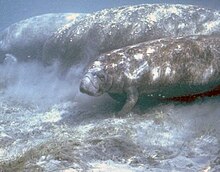
Sirenia is an order of fully aquatic, herbivorous mammals that inhabit rivers, estuaries, coastal marine waters, swamps, and marine wetlands.
- Family: Trichechidae
- Genus: Trichechus
- West Indian manatee, T. manatus VU
- Genus: Trichechus
The armadillos are small mammals with a bony armored shell. They are native to the Americas.
- Family: Dasypodidae (armadillos)
- Subfamily: Dasypodinae
- Genus: Dasypus
- Greater long-nosed armadillo, Dasypus kappleri LC
- Nine-banded armadillo, Dasypus novemcinctus LC
- Genus: Dasypus
- Subfamily: Tolypeutinae
- Genus: Cabassous
- Southern naked-tailed armadillo, Cabassous unicinctus LC
- Genus: Priodontes
- Giant armadillo, Priodontes maximus VU
- Genus: Cabassous
- Subfamily: Dasypodinae

The order Pilosa is extant only in the Americas and includes the anteaters, sloths, and tamanduas.
- Suborder: Folivora
- Family: Bradypodidae (three-toed sloths)
- Genus: Bradypus
- Pale-throated three-toed sloth, Bradypus tridactylus LC
- Genus: Bradypus
- Family: Choloepodidae (two-toed sloths)
- Genus: Choloepus
- Linnaeus's two-toed sloth, Choloepus didactylus LC
- Genus: Choloepus
- Family: Bradypodidae (three-toed sloths)
- Suborder: Vermilingua
- Family: Cyclopedidae
- Genus: Cyclopes
- Silky anteater, Cyclopes didactylus LC
- Genus: Cyclopes
- Family: Myrmecophagidae (American anteaters)
- Genus: Myrmecophaga
- Giant anteater, Myrmecophaga tridactyla NT
- Genus: Tamandua
- Southern tamandua, Tamandua tetradactyla LC
- Genus: Myrmecophaga
- Family: Cyclopedidae

The order Primates contains humans and their closest relatives: lemurs, lorisoids, monkeys, and apes.
- Suborder: Haplorhini
- Infraorder: Simiiformes
- Parvorder: Platyrrhini (New World monkeys)
- Family: Cebidae
- Subfamily: Callitrichinae
- Genus: Saguinus
- Red-handed tamarin, Saguinus midas LC
- Genus: Saguinus
- Subfamily: Cebinae
- Genus: Cebus
- Tufted capuchin, Cebus apella LC
- Weeper capuchin, Cebus olivaceus LC
- Genus: Saimiri
- Guianan squirrel monkey, Saimiri sciureus LC
- Genus: Cebus
- Subfamily: Callitrichinae
- Family: Pitheciidae
- Subfamily: Pitheciinae
- Genus: Pithecia
- White-faced saki, Pithecia pithecia LC
- Genus: Chiropotes
- Red-backed bearded saki, Chiropotes chiropotes LC
- Genus: Pithecia
- Subfamily: Pitheciinae
- Family: Atelidae
- Subfamily: Atelinae
- Genus: Ateles
- Red-faced spider monkey, Ateles paniscus LC
- Genus: Alouatta
- Guyanan red howler, Alouatta macconnelli LC
- Genus: Ateles
- Subfamily: Atelinae
- Family: Cebidae
- Parvorder: Platyrrhini (New World monkeys)
- Infraorder: Simiiformes




Rodents make up the largest order of mammals, with over 40% of mammalian species. They have two incisors in the upper and lower jaw which grow continually and must be kept short by gnawing. Most rodents are small though the capybara can weigh up to 45 kg (99 lb).
- Suborder: Hystricognathi
- Family: Erethizontidae (New World porcupines)
- Subfamily: Erethizontinae
- Genus: Coendou
- Brazilian porcupine, Coendou prehensilis LR/lc
- Genus: Coendou
- Subfamily: Erethizontinae
- Family: Caviidae (guinea pigs)
- Subfamily: Caviinae
- Genus: Cavia
- Brazilian guinea pig, Cavia aperea LR/lc
- Guinea pig, Cavia porcellus LR/lc
- Genus: Cavia
- Subfamily: Hydrochoerinae (capybaras and rock cavies)
- Genus: Hydrochoerus
- Capybara, Hydrochoerus hydrochaeris LR/lc
- Genus: Hydrochoerus
- Subfamily: Caviinae
- Family: Dasyproctidae (agoutis and pacas)
- Genus: Dasyprocta
- Black agouti, Dasyprocta fuliginosa LR/lc
- Red-rumped agouti, Dasyprocta leporina LR/lc
- Genus: Myoprocta
- Red acouchi, Myoprocta acouchy LR/lc
- Genus: Dasyprocta
- Family: Cuniculidae
- Genus: Cuniculus
- Lowland paca, Cuniculus paca LC
- Genus: Cuniculus
- Family: Echimyidae
- Subfamily: Echimyinae
- Genus: Isothrix
- Sinnamary brush-tailed rat, Isothrix sinnamariensis DD
- Genus: Makalata
- Brazilian spiny tree-rat, Makalata armata LR/lc
- Genus: Isothrix
- Subfamily: Eumysopinae
- Genus: Mesomys
- Ferreira's spiny tree rat, Mesomys hispidus LR/lc
- Genus: Proechimys
- Guyenne spiny rat, Proechimys cayennensis LR/lc
- Cuvier's spiny rat, Proechimys cuvieri LR/lc
- Guyanan spiny rat, Proechimys hoplomyoides LR/lc
- Genus: Mesomys
- Subfamily: Echimyinae
- Family: Erethizontidae (New World porcupines)
- Suborder: Sciurognathi
- Family: Sciuridae (squirrels)
- Subfamily: Sciurinae
- Tribe: Sciurini
- Genus: Sciurus
- Brazilian squirrel, Sciurus aestuans LR/lc
- Yellow-throated squirrel, Sciurus gilvigularis LR/lc
- Genus: Sciurus
- Tribe: Sciurini
- Subfamily: Sciurinae
- Family: Cricetidae
- Subfamily: Sigmodontinae
- Genus: Holochilus
- Amazonian marsh rat, Holochilus sciureus LR/lc
- Genus: Neacomys
- Guiana bristly mouse, Neacomys guianae LR/lc
- Common bristly mouse, Neacomys spinosus LR/lc
- Genus: Neusticomys
- Venezuelan fish-eating rat, Neusticomys venezuelae EN
- Genus: Oecomys
- Bicolored arboreal rice rat, Oecomys bicolor LR/lc
- Brazilian arboreal rice rat, Oecomys paricola LR/lc
- King arboreal rice rat, Oecomys rex LR/lc
- Robert's arboreal rice rat, Oecomys roberti LR/lc
- Red arboreal rice rat, Oecomys rutilus LR/lc
- Trinidad arboreal rice rat, Oecomys trinitatis LR/lc
- Genus: Oligoryzomys
- Fulvous pygmy rice rat, Oligoryzomys fulvescens LR/lc
- Genus: Oryzomys
- Azara's broad-headed rice rat, Oryzomys megacephalus LR/lc
- Yungas rice rat, Oryzomys yunganus LR/lc
- Genus: Podoxymys
- Roraima mouse, Podoxymys roraimae LR/nt
- Genus: Rhipidomys
- White-footed climbing mouse, Rhipidomys leucodactylus LR/lc
- MacConnell's climbing mouse, Rhipidomys macconnelli LR/lc
- Splendid climbing mouse, Rhipidomys nitela LR/lc
- Genus: Sigmodon
- Alston's cotton rat, Sigmodon alstoni LR/lc
- Genus: Zygodontomys
- Short-tailed cane rat, Zygodontomys brevicauda LR/lc
- Genus: Holochilus
- Subfamily: Sigmodontinae
- Family: Sciuridae (squirrels)
Order: Lagomorpha (lagomorphs)
[edit]The lagomorphs comprise two families, Leporidae (hares and rabbits), and Ochotonidae (pikas). Though they can resemble rodents, and were classified as a superfamily in that order until the early 20th century, they have since been considered a separate order. They differ from rodents in a number of physical characteristics, such as having four incisors in the upper jaw rather than two.
- Family: Leporidae (rabbits, hares)
- Genus: Sylvilagus
- Common tapetí, Sylvilagus brasiliensis EN
- Suriname tapetí, Sylvilagus parentum NE
- Genus: Sylvilagus
Order: Chiroptera (bats)
[edit]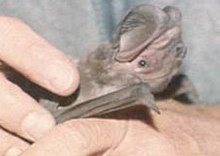
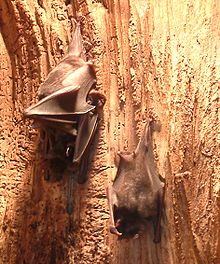
The bats' most distinguishing feature is that their forelimbs are developed as wings, making them the only mammals capable of flight. Bat species account for about 20% of all mammals.
- Family: Noctilionidae
- Genus: Noctilio
- Lesser bulldog bat, Noctilio albiventris LR/lc
- Greater bulldog bat, Noctilio leporinus LR/lc
- Genus: Noctilio
- Family: Vespertilionidae
- Subfamily: Myotinae
- Genus: Myotis
- Silver-tipped myotis, Myotis albescens LR/lc
- Black myotis, Myotis nigricans LR/lc
- Riparian myotis, Myotis riparius LR/lc
- Genus: Myotis
- Subfamily: Vespertilioninae
- Genus: Eptesicus
- Brazilian brown bat, Eptesicus brasiliensis LR/lc
- Argentine brown bat, Eptesicus furinalis LR/lc
- Genus: Lasiurus
- Greater red bat, Lasiurus atratus DD
- Desert red bat, Lasiurus blossevillii LR/lc
- Southern yellow bat, Lasiurus ega LR/lc
- Genus: Eptesicus
- Subfamily: Myotinae
- Family: Molossidae
- Genus: Cynomops
- Cinnamon dog-faced bat, Cynomops abrasus LR/nt
- Greenhall's dog-faced bat, Cynomops greenhalli LR/lc
- Southern dog-faced bat, Cynomops planirostris LR/lc
- Genus: Eumops
- Dwarf bonneted bat, Eumops bonariensis LR/lc
- Wagner's bonneted bat, Eumops glaucinus LR/lc
- Sanborn's bonneted bat, Eumops hansae LR/lc
- Guianan bonneted bat, Eumops maurus VU
- Western mastiff bat, Eumops perotis LR/lc
- Genus: Molossops
- Mato Grosso dog-faced bat, Molossops mattogrossensis LR/nt
- Genus: Molossus
- Black mastiff bat, Molossus ater LR/lc
- Velvety free-tailed bat, Molossus molossus LR/lc
- Miller's mastiff bat, Molossus pretiosus LR/lc
- Sinaloan mastiff bat, Molossus sinaloae LR/lc
- Genus: Nyctinomops
- Peale's free-tailed bat, Nyctinomops aurispinosus LR/lc
- Broad-eared bat, Nyctinomops laticaudatus LR/lc
- Big free-tailed bat, Nyctinomops macrotis LR/lc
- Genus: Promops
- Big crested mastiff bat, Promops centralis LR/lc
- Genus: Cynomops
- Family: Emballonuridae
- Genus: Centronycteris
- Shaggy bat, Centronycteris maximiliani LR/lc
- Genus: Cormura
- Wagner's sac-winged bat, Cormura brevirostris LR/lc
- Genus: Cyttarops
- Short-eared bat, Cyttarops alecto LR/nt
- Genus: Diclidurus
- Northern ghost bat, Diclidurus albus LR/lc
- Greater ghost bat, Diclidurus ingens VU
- Isabelle's ghost bat, Diclidurus isabella LR/nt
- Lesser ghost bat, Diclidurus scutatus LR/lc
- Genus: Peropteryx
- Greater dog-like bat, Peropteryx kappleri LR/lc
- White-winged dog-like bat, Peropteryx leucoptera LR/lc
- Genus: Rhynchonycteris
- Proboscis bat, Rhynchonycteris naso LR/lc
- Genus: Saccopteryx
- Greater sac-winged bat, Saccopteryx bilineata LR/lc
- Frosted sac-winged bat, Saccopteryx canescens LR/lc
- Lesser sac-winged bat, Saccopteryx leptura LR/lc
- Genus: Centronycteris
- Family: Mormoopidae
- Genus: Pteronotus
- Naked-backed bat, Pteronotus davyi LR/lc
- Big naked-backed bat, Pteronotus gymnonotus LR/lc
- Parnell's mustached bat, Pteronotus parnellii LR/lc
- Wagner's mustached bat, Pteronotus personatus LR/lc
- Genus: Pteronotus
- Family: Phyllostomidae
- Subfamily: Phyllostominae
- Genus: Glyphonycteris
- Davies's big-eared bat, Glyphonycteris daviesi LR/nt
- Genus: Lampronycteris
- Yellow-throated big-eared bat, Lampronycteris brachyotis LR/lc
- Genus: Lonchorhina
- Tomes's sword-nosed bat, Lonchorhina aurita LR/lc
- Genus: Lophostoma
- Pygmy round-eared bat, Lophostoma brasiliense LR/lc
- Carriker's round-eared bat, Lophostoma carrikeri VU
- Schultz's round-eared bat, Lophostoma schulzi VU
- White-throated round-eared bat, Lophostoma silvicolum LR/lc
- Genus: Macrophyllum
- Long-legged bat, Macrophyllum macrophyllum LR/lc
- Genus: Micronycteris
- Brosset's big-eared bat, Micronycteris brosseti DD
- Hairy big-eared bat, Micronycteris hirsuta LR/lc
- Little big-eared bat, Micronycteris megalotis LR/lc
- White-bellied big-eared bat, Micronycteris minuta LR/lc
- Genus: Mimon
- Golden bat, Mimon bennettii LR/lc
- Striped hairy-nosed bat, Mimon crenulatum LR/lc
- Genus: Phylloderma
- Pale-faced bat, Phylloderma stenops LR/lc
- Genus: Phyllostomus
- Pale spear-nosed bat, Phyllostomus discolor LR/lc
- Lesser spear-nosed bat, Phyllostomus elongatus LR/lc
- Greater spear-nosed bat, Phyllostomus hastatus LR/lc
- Genus: Tonatia
- Stripe-headed round-eared bat, Tonatia saurophila LR/lc
- Genus: Trachops
- Fringe-lipped bat, Trachops cirrhosus LR/lc
- Genus: Trinycteris
- Niceforo's big-eared bat, Trinycteris nicefori LR/lc
- Genus: Vampyrum
- Spectral bat, Vampyrum spectrum LR/nt
- Genus: Glyphonycteris
- Subfamily: Lonchophyllinae
- Genus: Lionycteris
- Chestnut long-tongued bat, Lionycteris spurrelli LR/lc
- Genus: Lonchophylla
- Thomas's nectar bat, Lonchophylla thomasi LR/lc
- Genus: Lionycteris
- Subfamily: Glossophaginae
- Genus: Anoura
- Tailed tailless bat, Anoura caudifer LR/lc
- Geoffroy's tailless bat, Anoura geoffroyi LR/lc
- Genus: Choeroniscus
- Godman's long-tailed bat, Choeroniscus godmani LR/nt
- Minor long-nosed long-tongued bat, Choeroniscus minor LR/lc
- Genus: Glossophaga
- Miller's long-tongued bat, Glossophaga longirostris LR/lc
- Pallas's long-tongued bat, Glossophaga soricina LR/lc
- Genus: Lichonycteris
- Dark long-tongued bat, Lichonycteris obscura LR/lc
- Genus: Anoura
- Subfamily: Carolliinae
- Genus: Carollia
- Chestnut short-tailed bat, Carollia castanea LR/lc
- Seba's short-tailed bat, Carollia perspicillata LR/lc
- Genus: Rhinophylla
- Dwarf little fruit bat, Rhinophylla pumilio LR/lc
- Genus: Carollia
- Subfamily: Stenodermatinae
- Genus: Ametrida
- Little white-shouldered bat, Ametrida centurio LR/lc
- Genus: Artibeus
- Large fruit-eating bat, Artibeus amplus LR/nt
- Gervais's fruit-eating bat, Artibeus cinereus LR/lc
- Silver fruit-eating bat, Artibeus glaucus LR/lc
- Jamaican fruit bat, Artibeus jamaicensis LR/lc
- Great fruit-eating bat, Artibeus lituratus LR/lc
- Pygmy fruit-eating bat, Artibeus phaeotis LR/lc
- Genus: Chiroderma
- Little big-eyed bat, Chiroderma trinitatum LR/lc
- Hairy big-eyed bat, Chiroderma villosum LR/lc
- Genus: Mesophylla
- MacConnell's bat, Mesophylla macconnelli LR/lc
- Genus: Sturnira
- Little yellow-shouldered bat, Sturnira lilium LR/lc
- Highland yellow-shouldered bat, Sturnira ludovici LR/lc
- Tilda's yellow-shouldered bat, Sturnira tildae LR/lc
- Genus: Uroderma
- Tent-making bat, Uroderma bilobatum LR/lc
- Brown tent-making bat, Uroderma magnirostrum LR/lc
- Genus: Vampyressa
- Bidentate yellow-eared bat, Vampyressa bidens LR/nt
- Brock's yellow-eared bat, Vampyressa brocki LR/nt
- Genus: Vampyrodes
- Great stripe-faced bat, Vampyrodes caraccioli LR/lc
- Genus: Platyrrhinus
- Short-headed broad-nosed bat, Platyrrhinus brachycephalus LR/lc
- Heller's broad-nosed bat, Platyrrhinus helleri LR/lc
- Genus: Ametrida
- Subfamily: Desmodontinae
- Genus: Diaemus
- White-winged vampire bat, Diaemus youngi LR/lc
- Genus: Diaemus
- Subfamily: Phyllostominae
- Family: Furipteridae
- Genus: Furipterus
- Thumbless bat, Furipterus horrens LR/lc
- Genus: Furipterus
- Family: Thyropteridae
- Genus: Thyroptera
- Peters's disk-winged bat, Thyroptera discifera LR/lc
- Spix's disk-winged bat, Thyroptera tricolor LR/lc
- Genus: Thyroptera

The order Cetacea includes whales, dolphins and porpoises. They are the mammals most fully adapted to aquatic life with a spindle-shaped nearly hairless body, protected by a thick layer of blubber, and forelimbs and tail modified to provide propulsion underwater.
- Suborder: Mysticeti
- Superfamily: Balaenopteroidea
- Family: Balaenopteridae
- Genus: Balaenoptera
- Common minke whale, Balaenoptera acutorostrata
- Sei whale, Balaenoptera borealis
- Bryde's whale, Balaenoptera brydei
- Blue whale, Balaenoptera musculus
- Fin whale, Balaenoptera physalus
- Genus: Megaptera
- Humpback whale, Megaptera novaeangliae
- Genus: Balaenoptera
- Family: Balaenopteridae
- Superfamily: Balaenopteroidea
- Suborder: Odontoceti
- Superfamily: Platanistoidea
- Family: Iniidae
- Family: Ziphidae
- Subfamily: Ziphiinae
- Genus: Ziphius
- Cuvier's beaked whale, Ziphius cavirostris DD
- Genus: Ziphius
- Subfamily: Hyperoodontinae
- Genus: Mesoplodon
- Blainville's beaked whale, Mesoplodon densirostris DD
- Gervais' beaked whale, Mesoplodon europaeus DD
- Genus: Mesoplodon
- Subfamily: Ziphiinae
- Family: Delphinidae (marine dolphins)
- Genus: Steno
- Rough-toothed dolphin, Steno bredanensis DD
- Genus: Sotalia
- Costero, Sotalia guianensis DD
- Genus: Stenella
- Atlantic spotted dolphin, Stenella frontalis DD
- Pantropical spotted dolphin, Stenella attenuata LR/cd
- Clymene dolphin, Stenella clymene DD
- Striped dolphin, Stenella coeruleoalba LR/cd
- Spinner dolphin, Stenella longirostris DD
- Genus: Tursiops
- Common bottlenose dolphin, Tursiops truncatus LR/lc
- Genus: Delphinus
- Long-beaked common dolphin, Delphinus capensis LR/lc
- Genus: Lagenodelphis
- Fraser's dolphin, Lagenodelphis hosei DD
- Genus: Feresa
- Pygmy killer whale, Feresa attenuata DD
- Genus: Globicephala
- Short-finned pilot whale, Globicephala macrorhynchus DD
- Genus: Orcinus
- Killer whale, Orcinus orca DD
- Genus: Peponocephala
- Melon-headed whale, Peponocephala electra DD
- Genus: Pseudorca
- False killer whale, Pseudorca crassidens DD
- Genus: Steno
- Family: Physeteridae
- Genus: Physeter
- Sperm whale, Physeter macrocephalus VU
- Genus: Physeter
- Family: Kogiidae
- Genus: Kogia
- Pygmy sperm whale, Kogia breviceps DD
- Dwarf sperm whale, Kogia sima DD
- Genus: Kogia
- Superfamily: Platanistoidea
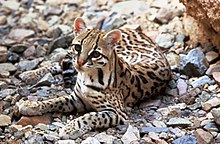
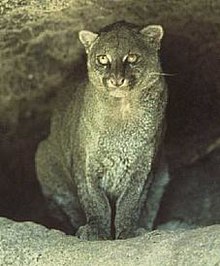

There are over 260 species of carnivorans, the majority of which feed primarily on meat. They have a characteristic skull shape and dentition.
- Suborder: Feliformia
- Family: Felidae (cats)
- Family: Herpestidae
- Genus: Urva
- Small Indian mongoose, U. auropunctata LC[7] introduced
- Genus: Urva
- Suborder: Caniformia
- Family: Canidae (dogs, foxes)
- Genus: Cerdocyon
- Crab-eating fox, Cerdocyon thous LC
- Genus: Speothos
- Bush dog, Speothos venaticus VU
- Genus: Cerdocyon
- Family: Procyonidae (raccoons)
- Genus: Procyon
- Crab-eating raccoon, Procyon cancrivorus
- Genus: Nasua
- South American coati, Nasua nasua
- Genus: Potos
- Kinkajou, Potos flavus
- Genus: Bassaricyon
- Eastern lowland olingo, Bassaricyon alleni
- Genus: Procyon
- Family: Mustelidae (mustelids)
- Genus: Eira
- Tayra, Eira barbara
- Genus: Galictis
- Greater grison, Galictis vittata
- Genus: Lontra
- Neotropical river otter, Lontra longicaudis DD
- Genus: Neogale
- Long-tailed weasel, Neogale frenata
- Genus: Pteronura
- Giant otter, Pteronura brasiliensis EN
- Genus: Eira
- Family: Mephitidae
- Genus: Conepatus
- Striped hog-nosed skunk, Conepatus semistriatus
- Genus: Conepatus
- Family: Canidae (dogs, foxes)
Order: Perissodactyla (odd-toed ungulates)
[edit]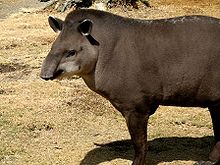
The odd-toed ungulates are browsing and grazing mammals. They are usually large to very large, and have relatively simple stomachs and a large middle toe.
- Family: Tapiridae (tapirs)
- Genus: Tapirus
- Brazilian tapir, Tapirus terrestris VU
- Genus: Tapirus
Order: Artiodactyla (even-toed ungulates)
[edit]
The even-toed ungulates are ungulates whose weight is borne about equally by the third and fourth toes, rather than mostly or entirely by the third as in perissodactyls.
- Family: Tayassuidae (peccaries)
- Genus: Dicotyles
- Collared peccary, D. tajacu LC
- Genus: Tayassu
- White-lipped peccary, Tayassu pecari NT
- Genus: Dicotyles
- Family: Cervidae (deer)
- Subfamily: Capreolinae
- Genus: Mazama
- Red brocket, Mazama americana DD
- Gray brocket, Mazama gouazoupira DD
- Genus: Odocoileus
- White-tailed deer, Odocoileus virginianus LR/lc
- Genus: Mazama
- Subfamily: Capreolinae
Infraclass: Metatheria
[edit]Order: Didelphimorphia (common opossums)
[edit]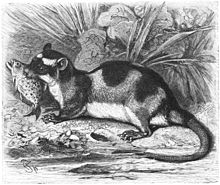
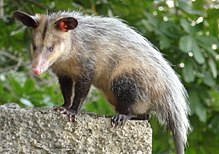
Didelphimorphia is the order of common opossums of the Western Hemisphere. Opossums probably diverged from the basic South American marsupials in the late Cretaceous or early Paleocene. They are small to medium-sized marsupials, about the size of a large house cat, with a long snout and prehensile tail.
- Family: Didelphidae (American opossums)
- Subfamily: Caluromyinae
- Genus: Caluromys
- Bare-tailed woolly opossum, Caluromys philander LR/nt
- Genus: Caluromys
- Subfamily: Didelphinae
- Genus: Chironectes
- Water opossum, Chironectes minimus LR/nt
- Genus: Didelphis
- White-eared opossum, Didelphis albiventris LR/lc
- Common opossum, Didelphis marsupialis LR/lc
- Genus: Hyladelphys
- Kalinowski's mouse opossum, Hyladelphys kalinowskii DD
- Genus: Lutreolina
- Big lutrine opossum, Lutreolina crassicaudata LR/lc
- Genus: Marmosa
- Woolly mouse opossum, Marmosa demerarae LR/lc
- Linnaeus's mouse opossum, Marmosa murina LR/lc
- Genus: Marmosops
- Delicate slender opossum, Marmosops parvidens LR/nt
- Genus: Metachirus
- Brown four-eyed opossum, Metachirus nudicaudatus LR/lc
- Genus: Philander
- Gray four-eyed opossum, Philander opossum LR/lc
- Genus: Chironectes
- Subfamily: Caluromyinae
See also
[edit]- List of chordate orders
- Lists of mammals by region
- List of prehistoric mammals
- Mammal classification
- List of mammals described in the 2000s
References
[edit]- ^ Caso, A.; de Oliveira, T. & Carvajal, S.V. (2015). "Herpailurus yagouaroundi". IUCN Red List of Threatened Species. 2015: e.T9948A50653167.
- ^ Paviolo, A.; Crawshaw, P.; Caso, A.; de Oliveira, T.; Lopez-Gonzalez, C.A.; Kelly, M.; De Angelo, C. & Payan, E. (2015). "Leopardus pardalis". IUCN Red List of Threatened Species. 2015: e.T11509A97212355.
- ^ Payan, E. & de Oliveira, T. (2016). "Leopardus tigrinus". IUCN Red List of Threatened Species. 2016: e.T54012637A50653881.
- ^ de Oliveira, T.; Paviolo, A.; Schipper, J.; Bianchi, R.; Payan, E. & Carvajal, S.V. (2015). "Leopardus wiedii". IUCN Red List of Threatened Species. 2015: e.T11511A50654216.
- ^ Nielsen, C.; Thompson, D.; Kelly, M. & Lopez-Gonzalez, C. A. (2015). "Puma concolor". IUCN Red List of Threatened Species. 2015: e.T18868A97216466.
- ^ Quigley, H.; Foster, R.; Petracca, L.; Payan, E.; Salom, R. & Harmsen, B. (2017). "Panthera onca". IUCN Red List of Threatened Species. 2017: e.T15953A123791436.
- ^ Jennings, A.; Veron, G. (2016). "Herpestes auropunctatus". IUCN Red List of Threatened Species. 2016: e.T70204120A70204139. doi:10.2305/IUCN.UK.2016-1.RLTS.T70204120A70204139.en. Retrieved 18 November 2021.
External links
[edit]- "Animal Diversity Web". University of Michigan Museum of Zoology. 1995–2006. Retrieved 22 May 2007.